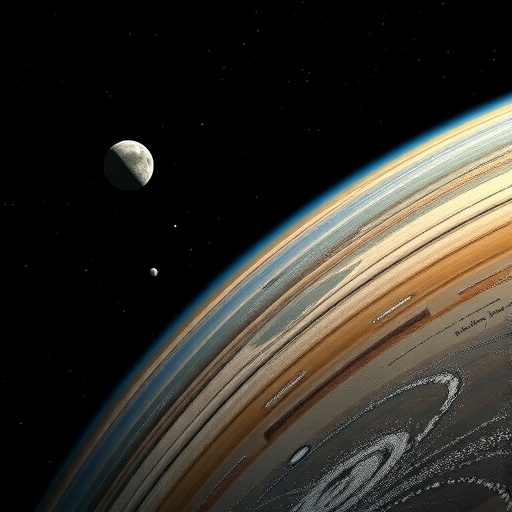In a groundbreaking new study published in Nature Communications, a team of researchers has unveiled compelling evidence that the timing and nature of sediment failure—critical events influencing underwater landslides and subsea hazards—are preconditioned by weak-layer deposits paced not by chance but by astronomical forces. This revelation sheds fresh light on the intricate processes underlying sediment stability in deep-sea environments, underscoring how cyclical astronomical events can govern what was previously considered a sporadic phenomenon.
For decades, understanding the triggers behind sediment failure has remained a challenge for geologists and oceanographers alike. These failures contribute significantly to underwater landslides, which have the potential to disrupt seafloor infrastructure, generate tsunamis, and reshape marine landscapes. While it was known that such failures often arise from complex interactions between sediment composition, seabed topography, and external forces, the exact mechanisms leading to failure timing had remained elusive. Wang and colleagues have now demonstrated that weak layers within sediment deposits, which critically control sediment stability, are themselves structured by astronomically paced depositional cycles.
The research hinges upon detailed sediment core analysis from oceanic regions where repeated sediment failure events have been documented. By combining stratigraphic methods with high-resolution dating techniques, the team identified distinct layers of weak sediment interspersed within stronger deposits. These weak layers, which are responsible for predisposing sediments to fail under stress, align closely with known cycles in Earth’s orbital variations—phenomena that have long influenced climate patterns and sea levels but were not previously linked directly to sediment mechanical properties.
Understanding this pacing is no trivial matter. The orbital cycles—ranging from tens to hundreds of thousands of years—modulate environmental conditions such as sediment supply, organic matter deposition, and chemical diagenesis. These factors collectively determine the physical characteristics of sediment layers, including grain size, consolidation state, and shear strength. By correlating sediment weakness with these astronomically regulated deposition intervals, the study offers a predictive framework for future sediment failure risks based on Earth’s well-characterized orbital variations.
Such findings also dive into the microscale interactions within sediment matrices, where subtle changes in grain contact, pore fluid pressures, and mineralogical composition driven by deposition rates directly impact the mechanical thresholds of slope stability. The astronomically paced regime implies that sediment failure risk does not occur randomly but instead follows a quasi-periodic pattern dictated by these celestial rhythms. This insight not only transforms theoretical models of sediment failure but has practical implications for subsea infrastructure management and hazard mitigation.
To arrive at these conclusions, the researchers utilized advanced sedimentological techniques such as X-ray computed tomography scanning combined with geochemical fingerprinting, which allowed characterization of the weak layers in unprecedented detail. Additionally, the temporal resolution afforded by astronomical tuning of sediment ages provided a robust chronological framework to link weak layer deposition with known cyclic changes in Earth’s orbit parameters, including eccentricity, obliquity, and precession.
The implications of this discovery extend across multiple domains of Earth science. For example, the knowledge that sediment failures follow astronomically controlled weak-layer deposition patterns can refine numerical models predicting submarine landslides and their resulting geohazards. These models, often reliant on sediment mechanical properties and external trigger conditions, will now incorporate weak layer cyclical formation as a fundamental boundary condition.
Moreover, this research underscores Earth system interconnectedness, highlighting the influence of astronomical mechanics far beyond climate modulation, reaching into the structural integrity of marine sediments. Such interlinkages have been largely underappreciated in marine geology but may also inform analogies in terrestrial slope failures where sedimentary layering and deposition cycles play roles dictated by longer-term climatic oscillations.
Importantly, the study’s findings might recalibrate the understanding of the frequency and magnitude of sediment failure events in different geologic epochs, especially during periods of significant orbital forcing known from paleoclimate records. Sediment failure events not only sculpt the seafloor morphology but also influence carbon cycling via disturbance of organic-rich layers, impacting broader biogeochemical cycles.
The discovery opens avenues for further multidisciplinary investigations involving sedimentologists, oceanographers, and astronomers alike. It encourages a reevaluation of sediment failure triggers within a framework that accounts for astronomical pacing over geologic timescales, inviting models that can predict not only when but possibly where sediment failures may concentrate based on depositional history aligned with orbital variations.
Wang and colleagues’ findings also bring to light the importance of weak-layer characterization in assessing sediment stability. Their formation through periodic depositional environments leads to mechanical contrasts between sediment beds that harbor underlying failure risks. This aspect challenges prior assumptions that sediment failure susceptibility mainly arises from sudden external shocks or rapid sediment loading, instead showing long-term depositional history as a primary factor.
The nexus of sediment failure and astronomical cycles may inspire novel monitoring strategies, particularly in ocean basins prone to underwater landslides where sediment cores can reveal past weak-layer sequences. These insights can be leveraged to establish early warning systems or to guide the siting and design of subsea pipelines, communication cables, and drilling platforms to mitigate catastrophic failure risks.
In conclusion, the study sets a new paradigm in sedimentology and marine geohazard science by tying the temporal genesis of sediment weak layers—and thus failure predisposition—to the cosmic scale of Earth’s orbital dynamics. This profound interconnection between astronomical forcing and sediment stability fosters a deeper appreciation of Earth’s evolving geosystem and enhances our predictive capability for sediment failure and associated hazards in the future.
With sediment failure events posing increasing risks due to growing subsea industrial activity and climate change-induced sea-level variations, integrating insights such as those presented by Wang and team will be crucial. Their meticulous research lays a foundation for future explorations into the cosmic rhythms shaping our planet’s underwater landscapes and advances the quest to protect infrastructure, ecosystems, and communities vulnerable to sediment instability phenomena.
Subject of Research: Sediment failure and weak-layer deposition controlled by astronomical cycles
Article Title: Preconditioning of sediment failure by astronomically paced weak-layer deposition
Article References:
Wang, X., Maselli, V., Flessati, L. et al. Preconditioning of sediment failure by astronomically paced weak-layer deposition. Nat Commun 16, 7244 (2025). https://doi.org/10.1038/s41467-025-62493-4
Image Credits: AI Generated




